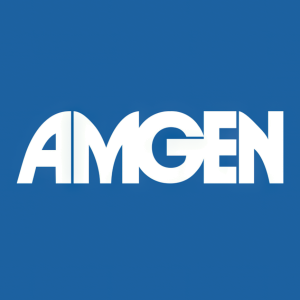AMGEN PRESENTS POSITIVE PHASE 3 DATA FOR UPLIZNA® (INEBILIZUMAB-CDON) IN GENERALIZED MYASTHENIA GRAVIS (GMG) AT AANEM 2024
Rhea-AI Summary
Amgen (NASDAQ:AMGN) presented positive Phase 3 data for UPLIZNA® (inebilizumab-cdon) in treating generalized myasthenia gravis (gMG) at AANEM 2024. The MINT study met its primary endpoint, showing a statistically significant change in MG-ADL score for UPLIZNA (-4.2) compared to placebo (-2.2) at Week 26. The trial included both AChR+ and MuSK+ patients, with continued improvement through Week 26. Notably, corticosteroid use was tapered down during the study.
Key secondary endpoints also showed significant improvements, including changes in QMG scores and MG-ADL scores for specific patient populations. The safety profile was consistent with previous findings. MINT is the largest placebo-controlled gMG clinical trial for a biologic therapy, enrolling 238 adults. Amgen plans to file for approval in the U.S. and other key markets based on these results.
Positive
- UPLIZNA met its primary endpoint with statistically significant improvement in MG-ADL score (-4.2) compared to placebo (-2.2)
- Demonstrated continued improvement through Week 26
- Achieved statistically significant results in key secondary endpoints
- Largest placebo-controlled gMG clinical trial for a biologic therapy (238 adults)
- No new safety signals identified
- Plans to file for approval in the U.S. and other key markets
Negative
- In the MuSK+ population, the change in QMG score was not statistically significant
News Market Reaction 1 Alert
On the day this news was published, AMGN gained 0.14%, reflecting a mild positive market reaction.
Data tracked by StockTitan Argus on the day of publication.
MINT Study Results Show Clinically Meaningful and Statistically Significant Efficacy in AChR+ and MuSK+ Patients
First and Only Phase 3 Placebo-Controlled gMG Trial for a Biologic That Tapered Corticosteroid Use
The trial met its primary endpoint, with a statistically significant change from baseline in Myasthenia Gravis Activities of Daily Living (MG-ADL) score for UPLIZNA (-4.2) compared with placebo (-2.2) (difference: –1.9, p<0.0001) at Week 26 for the combined study population. The study included patients who are acetylcholine receptor autoantibody-positive (AChR+) and those who are muscle-specific kinase autoantibody-positive (MuSK+), with participants receiving UPLIZNA or placebo on Day 1 and Day 15. UPLIZNA demonstrated continued improvement through Week 26. Notably, patients who entered the study taking corticosteroids were tapered down starting at Week 4 to prednisone 5 mg per day by Week 24. No new safety signals were identified.
"Patients living with generalized myasthenia gravis deserve an effective treatment option that provides long-term symptom relief. Once approved, UPLIZNA is expected to offer a new option for patients earlier in their treatment plan," said Jay Bradner, M.D., executive vice president, Research and Development, and chief scientific officer at Amgen. "UPLIZNA targets CD19+ pre-B cells, mature B-cells and some plasmablasts, which are drivers of the disease. The clinically significant results from the MINT trial further strengthen the growing evidence for UPLIZNA in severe autoimmune diseases and reinforce Amgen's leadership in B-cell targeting therapeutics."
Key secondary endpoints were tested sequentially in a predefined order. UPLIZNA demonstrated a statistically significant and clinically meaningful change from baseline compared to placebo for the first four key secondary endpoints.
- UPLIZNA demonstrated a statistically significant change in Quantitative Myasthenia Gravis (QMG) score for the combined population (-4.8) compared to placebo (-2.3) at Week 26 (difference: -2.5, p=0.0002).
- In the AChR+ population, UPLIZNA demonstrated mean change from baseline (-4.2) in MG-ADL score at Week 26 compared to placebo (-2.4) (difference: -1.8, p=0.0015).
- In the AChR+ population, UPLIZNA demonstrated mean change from baseline (-4.4) in QMG score at Week 26 compared to placebo (-2.0) (difference -2.5, p=0.0011).
- In the MuSK+ population, UPLIZNA demonstrated mean change from baseline (-3.9) in MG-ADL score at Week 26 compared to placebo (-1.7) (difference -2.2, p=0.0297).
Additionally, in the MuSK+ population, the mean change from baseline in QMG score at Week 26 showed a trend favoring UPLIZNA but was not statistically significant (-5.2 for UPLIZNA and -3.0 for placebo, difference -2.3, p=0.1326).
"Myasthenia gravis can have a profound impact on patients by causing severe fatigable muscle weakness that impairs physical functioning, activities of daily living and quality of life," said Richard J. Nowak, M.D., M.S., global principal study investigator and director of the Myasthenia Gravis Clinic at Yale University. "This trial demonstrates clinically meaningful benefits of UPLIZNA, a twice-yearly infused medicine with a unique mechanism of action that selectively targets and depletes CD19+ B cells, which are key upstream drivers of myasthenia gravis. MINT is also the only Phase 3 biologic trial that included a protocol-specified steroid taper, an important consideration for patients as effects of prolonged high-dose steroid use contribute to the overall burden of disease."
The overall safety results during the placebo-controlled period of the trial were consistent with the known safety profile of UPLIZNA. The most common treatment-emergent adverse events were COVID-19, nasopharyngitis, urinary tract infection, infusion related reaction, headache and cough in the combined population.
MINT is the largest placebo-controlled gMG clinical trial for a biologic therapy (238 adults) and enrolled the largest number of patients (48 adults) who are MuSK+. The trial also included 190 adults who are AChR+. Further data will characterize placebo-controlled efficacy and safety of UPLIZNA over 12 months in AChR+ patients with gMG.
At the 2024 AANEM Annual Meeting, Amgen will also be presenting a poster titled, "The Burden of Glucocorticoid Use Among Patients with Generalized Myasthenia Gravis in
UPLIZNA is currently approved for the treatment of neuromyelitis optica spectrum disorder (NMOSD) in adult patients who are anti-aquaporin-4 (AQP4) antibody positive in
Based on the MINT primary results, Amgen is planning to file for approval in the
About the MINT Trial
The MINT trial is a randomized, double-blind, placebo-controlled, parallel-group trial (NCT04524273) evaluating the efficacy and safety of UPLIZNA in adults with gMG. The trial enrolled 238 adults with gMG, including 190 patients who are acetylcholine receptor autoantibody-positive (AChR+) and 48 patients who are muscle-specific kinase autoantibody-positive (MuSK+).
Eligibility criteria at screening and randomization included a Myasthenia Gravis Foundation of America (MGFA) classification of II, III, or IV disease, MG-ADL score between 6 and 10 with greater than
The primary endpoint was change from baseline in MG-ADL score at Week 26 in the combined population. Key secondary endpoints included change from baseline in QMG scores in the combined study population; change from baseline in MG-ADL score at Week 26 for the AChR+ cohort and separately the MuSK+ cohort; and change from baseline in QMG score at Week 26 for the AChR+ cohort and separately the MuSK+ cohort. Patients who entered the study taking a corticosteroid were tapered down to prednisone 5 mg a day, starting at Week 4 to Week 24. The MINT trial also includes an optional three-year open-label treatment period.
About Generalized Myasthenia Gravis (gMG)
Generalized myasthenia gravis (gMG) is a rare, chronic, B-cell-mediated autoimmune disorder that impairs neuromuscular communication and can cause muscle weakness, trouble breathing, difficulty swallowing and impaired speech and vision.1-4 Approximately
The prevalence and incidence of gMG are increasing worldwide.5 There are between 80,000 and 100,000 patients with myasthenia gravis in the
B cells are central to the pathogenesis of gMG. The disease is thought to be primarily driven by pathogenic CD19+ plasmablasts and plasma cells that target critical proteins in the neuromuscular junction.1-3
About UPLIZNA® (inebilizumab-cdon) in NMOSD
INDICATION
UPLIZNA® (inebilizumab-cdon) is indicated for the treatment of neuromyelitis optica spectrum disorder (NMOSD) in adult patients who are anti-aquaporin-4 (AQP4) antibody positive.
IMPORTANT SAFETY INFORMATION
UPLIZNA is contraindicated in patients with:
- A history of life-threatening infusion reaction to UPLIZNA
- Active hepatitis B infection
- Active or untreated latent tuberculosis
WARNINGS AND PRECAUTIONS
Infusion Reactions: UPLIZNA can cause infusion reactions, which can include headache, nausea, somnolence, dyspnea, fever, myalgia, rash, or other symptoms. Infusion reactions were most common with the first infusion but were also observed during subsequent infusions. Administer pre-medication with a corticosteroid, an antihistamine, and an anti-pyretic.
Infections: The most common infections reported by UPLIZNA-treated patients in the randomized and open-label periods included urinary tract infection (
Increased immunosuppressive effects are possible if combining UPLIZNA with another immunosuppressive therapy.
The risk of Hepatitis B Virus (HBV) reactivation has been observed with other B-cell-depleting antibodies. Perform HBV screening in all patients before initiation of treatment with UPLIZNA. Do not administer to patients with active hepatitis.
Although no confirmed cases of Progressive Multifocal Leukoencephalopathy (PML) were identified in UPLIZNA clinical trials, JC virus infection resulting in PML has been observed in patients treated with other B-cell-depleting antibodies and other therapies that affect immune competence. At the first sign or symptom suggestive of PML, withhold UPLIZNA and perform an appropriate diagnostic evaluation.
Patients should be evaluated for tuberculosis risk factors and tested for latent infection prior to initiating UPLIZNA.
Vaccination with live-attenuated or live vaccines is not recommended during treatment and after discontinuation, until B-cell repletion.
Reduction in Immunoglobulins: There may be a progressive and prolonged hypogammaglobulinemia or decline in the levels of total and individual immunoglobulins such as immunoglobulins G and M (IgG and IgM) with continued UPLIZNA treatment. Monitor the level of immunoglobulins at the beginning, during, and after discontinuation of treatment with UPLIZNA until B-cell repletion especially in patients with opportunistic or recurrent infections.
Fetal Risk: May cause fetal harm based on animal data. Advise females of reproductive potential of the potential risk to a fetus and to use an effective method of contraception during treatment and for 6 months after stopping UPLIZNA.
Adverse Reactions: The most common adverse reactions (at least
For additional information on UPLIZNA, please see the Full Prescribing Information at www.UPLIZNA.com.
About Amgen
Amgen discovers, develops, manufactures, and delivers innovative medicines to help millions of patients in their fight against some of the world's toughest diseases. More than 40 years ago, Amgen helped to establish the biotechnology industry and remains on the cutting-edge of innovation, using technology and human genetic data to push beyond what's known today. Amgen is advancing a broad and deep pipeline that builds on its existing portfolio of medicines to treat cancer, heart disease, osteoporosis, inflammatory diseases and rare diseases.
In 2024, Amgen was named one of the "World's Most Innovative Companies" by Fast Company and one of "America's Best Large Employers" by Forbes, among other external recognitions. Amgen is one of the 30 companies that comprise the Dow Jones Industrial Average®, and it is also part of the Nasdaq-100 Index®, which includes the largest and most innovative non-financial companies listed on the Nasdaq Stock Market based on market capitalization.
For more information, visit Amgen.com and follow Amgen on X, LinkedIn, Instagram, TikTok, YouTube and Threads.
Forward-Looking Statements
This news release contains forward-looking statements that are based on the current expectations and beliefs of Amgen. All statements, other than statements of historical fact, are statements that could be deemed forward-looking statements, including any statements on the outcome, benefits and synergies of collaborations, or potential collaborations, with any other company (including BeiGene, Ltd. or Kyowa Kirin Co., Ltd.), the performance of Otezla® (apremilast) (including anticipated Otezla sales growth and the timing of non-GAAP EPS accretion), our acquisitions of Teneobio, Inc., ChemoCentryx, Inc., or Horizon Therapeutics plc (including the prospective performance and outlook of Horizon's business, performance and opportunities, any potential strategic benefits, synergies or opportunities expected as a result of such acquisition, and any projected impacts from the Horizon acquisition on our acquisition-related expenses going forward), as well as estimates of revenues, operating margins, capital expenditures, cash, other financial metrics, expected legal, arbitration, political, regulatory or clinical results or practices, customer and prescriber patterns or practices, reimbursement activities and outcomes, effects of pandemics or other widespread health problems on our business, outcomes, progress, and other such estimates and results. Forward-looking statements involve significant risks and uncertainties, including those discussed below and more fully described in the Securities and Exchange Commission reports filed by Amgen, including our most recent annual report on Form 10-K and any subsequent periodic reports on Form 10-Q and current reports on Form 8-K. Unless otherwise noted, Amgen is providing this information as of the date of this news release and does not undertake any obligation to update any forward-looking statements contained in this document as a result of new information, future events or otherwise.
No forward-looking statement can be guaranteed and actual results may differ materially from those we project. Discovery or identification of new product candidates or development of new indications for existing products cannot be guaranteed and movement from concept to product is uncertain; consequently, there can be no guarantee that any particular product candidate or development of a new indication for an existing product will be successful and become a commercial product. Further, preclinical results do not guarantee safe and effective performance of product candidates in humans. The complexity of the human body cannot be perfectly, or sometimes, even adequately modeled by computer or cell culture systems or animal models. The length of time that it takes for us to complete clinical trials and obtain regulatory approval for product marketing has in the past varied and we expect similar variability in the future. Even when clinical trials are successful, regulatory authorities may question the sufficiency for approval of the trial endpoints we have selected. We develop product candidates internally and through licensing collaborations, partnerships and joint ventures. Product candidates that are derived from relationships may be subject to disputes between the parties or may prove to be not as effective or as safe as we may have believed at the time of entering into such relationship. Also, we or others could identify safety, side effects or manufacturing problems with our products, including our devices, after they are on the market.
Our results may be affected by our ability to successfully market both new and existing products domestically and internationally, clinical and regulatory developments involving current and future products, sales growth of recently launched products, competition from other products including biosimilars, difficulties or delays in manufacturing our products and global economic conditions. In addition, sales of our products are affected by pricing pressure, political and public scrutiny and reimbursement policies imposed by third-party payers, including governments, private insurance plans and managed care providers and may be affected by regulatory, clinical and guideline developments and domestic and international trends toward managed care and healthcare cost containment. Furthermore, our research, testing, pricing, marketing and other operations are subject to extensive regulation by domestic and foreign government regulatory authorities. Our business may be impacted by government investigations, litigation and product liability claims. In addition, our business may be impacted by the adoption of new tax legislation or exposure to additional tax liabilities. If we fail to meet the compliance obligations in the corporate integrity agreement between us and the
Any scientific information discussed in this news release relating to new indications for our products is preliminary and investigative and is not part of the labeling approved by the
CONTACT: Amgen,
Madison Howard, 773-636-4910 (media)
Elissa Snook, 609-251-1407 (media)
Justin Claeys, 805-313-9775 (investors)
References
- Yi, J. S., Guptill, J. T., Stathopoulos, P., Nowak, R. J., & O'Connor, K. C. (2018). B cells in the pathophysiology of myasthenia gravis. Muscle Nerve, 57(2):172-184.
- Willcox H. N., Newsom-Davis, J., & Calder, L. R. (1984). Cell types required for anti-acetylcholine receptor antibody synthesis by cultured thymocytes and blood lymphocytes in myasthenia gravis. Clinical and Experimental Immunology., 58:97-106.
- Stathopoulos P., Kumar, A., Nowak, R. J., & O'Connor, K. C. (2017). Autoantibody-producing plasmablasts after B cell depletion identified in muscle-specific kinase myasthenia gravis. JCI Insight, 2(17):e94263.
- Lazaridis K., & Tzartos, S. J. (2020). Autoantibody Specificities in Myasthenia Gravis; Implications for Improved Diagnostics and Therapeutics. Frontiers in Immunology, 11:212.
- Dresser L., Wlodarski, R., Rezania, K., & Soliven, B. (2021). Myasthenia Gravis: Epidemiology, Pathophysiology and Clinical Manifestations. J Clin Med, 10(11):2235.
- Ye et al. Frontiers in Neurology. (2024);15:1339167.
- Rodrigues E., Umeh, E., Aishwarya, Navaratnarajah, N., Cole, A., & Moy, K. (2024). Incidence and prevalence of myasthenia gravis in
the United States : A claims-based analysis. Muscle Nerve, 69(2):166-171. - Hehir, M. K., & Silvestri, N. J. (2018). Generalized myasthenia gravis: classification, clinical presentation, natural history, and epidemiology. Neurologic Clinics, 36:253-60.
- Bubuioc, A. M., Kudebayeva, A., Turuspekova, S., Lisnic, V., & Leone, M. A. (2021). The epidemiology of myasthenia gravis. Journal of Medicine and Life, 14(1):7-16.
![]() View original content to download multimedia:https://www.prnewswire.com/news-releases/amgen-presents-positive-phase-3-data-for-uplizna-inebilizumab-cdon-in-generalized-myasthenia-gravis-gmg-at-aanem-2024-302275645.html
View original content to download multimedia:https://www.prnewswire.com/news-releases/amgen-presents-positive-phase-3-data-for-uplizna-inebilizumab-cdon-in-generalized-myasthenia-gravis-gmg-at-aanem-2024-302275645.html
SOURCE Amgen










